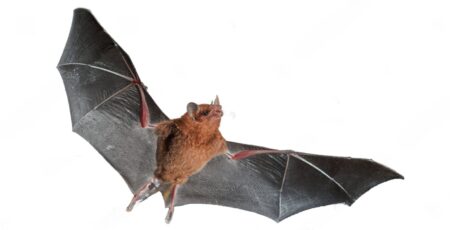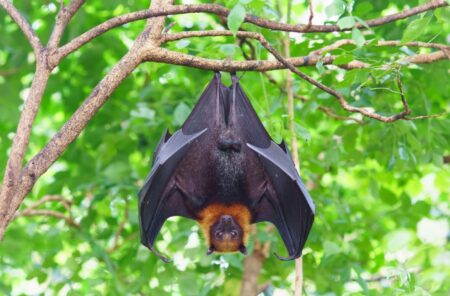Are Bats Birds Or Rodents
Are Bats Birds Or Rodents? The answer is that bats are not birds or rodents. Bats are a separate classification of mammals, within the order Chiroptera. Bats differ from birds and rodents in their anatomy, physiology, and behavior. Most notably, bats are the only mammals that can truly fly (some rodents may glide, but they cannot truly fly). Bats also have different feeding habits than birds and rodents, they often use echolocation to locate and capture their prey.
Are Bats Birds Or Rodents?
No, bats are not birds or rodents. Bats are mammals of the order Chiroptera, which consists of almost 1,200 species of bats. They are the only mammals capable of sustained flight, as opposed to gliding. Bats come in many different sizes, from the tiny bumblebee bat of Thailand which is no bigger than a thumbnail, to the giant golden-crowned flying foxes in the Philippines which can have a wingspan of up to 6 feet (1.8 m). Bats are found on every continent except Antarctica.
Are Bats Birds?
Bats are not birds because they do not belong to the same biological order; birds are in the class Aves while bats are in the class Mammalia.
Bats and birds have some similarities, however, they are still classified in two separate scientific orders.
Bats are more closely related to primates and rodents as they share more anatomical and genetic characteristics with these animals than they do with birds. They have flexible, membranous wings and a distinctive claw at the end of each finger that make them adapted for flying. Bats also lack four toes which birds have.
Bats and birds also typically have dissimilar diets. While most birds are predators and eat insects, fruit, and seeds, most bats are insectivores or nectar and fruit eaters. Even in the small percentage of cases where bats exhibit predatory behavior, they usually hunt very small animals such as scorpions, spiders, and centipedes, not birds.
Finally, bats also have much different social behavior than birds, with all species of bats typically roosting in large colonies to keep warm, as opposed to birds who are usually solitary. The reproductive cycle of bats is also different than that of birds, as the majority of bats reproduce only once a year while most birds can reproduce several times a year.
To summarise, bats and birds belong to two different biological orders, and have significantly different anatomy, diets, reproductive habits, and social behavior which all set them apart from one another.
Is A Bat Classified As A Rodent?
No, a bat is not classified as a rodent. Bats are classified as a separate order of mammals called Chiroptera. Rodents are a different order of mammals called Rodentia. Bats and rodents have some similarities in their habits, such as both being nocturnal and living in colonies, but their anatomy and physiology are quite different.
What Is A Bat Classified As?
A bat is classified as a mammal. Bats are the only flying mammal and are capable of sustained, powered flight. They are members of the order Chiroptera, which is divided into two suborders: Megachiroptera, or fruit bats, and Microchiroptera, or microbats.
How Are Bats Related To Humans?
Bats are related to humans in a number of different ways, both physically and biologically.
Physically, bats are mammals, just like humans, and they belong to the order Chiroptera, which includes around 1,300 species of bats and closely related creatures, such as flying foxes. They have wings, just like humans, and they are the only mammals that are capable of sustained powered flight.
On a biological level, bats are closely related to us in many ways. They have the same number of chromosomes that humans have, and they are considered to be one of the more primitive forms of mammals, meaning that they have many features that we have on a molecular level. For example, bats use the same EGF receptor gene that humans have, which is responsible for cell growth and is essential for development.
Another interesting similarity between bats and humans is that they both rely on odor-detecting chemo-sensors for navigation. They depend on their sense of smell to locate food, and they both have the same nucleotide sequences for sensing odors, meaning that they are related on a genetic level too.
Finally, bats also often form social groups, just like humans. It’s believed that they even have the capacity for culture, which is an extremely sophisticated behavior that is unique to primates.
So, in conclusion, bats are related to humans both physically and biologically in a number of ways. This highlights the importance of preserving these amazing creatures, as their loss would have an impact on our own species too.
10 Characteristics Of Bats
- Flight: Bats are the only mammal that can fly. They use their wings to generate lift when they flap them, and they have been observed flying for up to three hours at a time.
- Nocturnal: Bats are nocturnal, meaning they are most active at night. This is due to the fact that they hunt insects, which are most active in the dark.
- Echolocation: Bats use a special type of navigation known as echolocation. They emit high-frequency, focused sound waves; these bounce off of objects around them, giving them an idea of their location and environment.
- Migration: Bats migrate in order to survive long, cold winters. Some bats will fly over one thousand kilometers in the winter, while others will hibernate for the season.
- Social: Bats often live in colonies, and display elaborate social behaviors. They will groom and cuddle with one another, and play games of tag.
- Diet: Bats are mostly insectivorous, meaning they eat primarily insects. However, some species of bats will also feed on nectar and fruit.
- Teeth: Bats have a unique type of dentition known as negative heterodonty. This means that the upper incisors of their mouth are smaller than the lower incisors, allowing the bats to feed on small insect prey.
- Senses: Bats have a highly developed sense of hearing, which is used in part for echolocation. They also have excellent vision and an acute sense of smell.
- Reproductive Strategies: Bats exhibit a range of reproductive strategies, from monogamous pair bonding to polygyny.
- Fly Groom: Bats have a special behavior known as fly grooming. This occurs when a bat is grooming itself, as well as cleaning its wings as they are flapping.
Difference Between Bats And Rodents
- Bats are mammals of the order Chiroptera, while rodents are mammals of the order Rodentia.
- Bats have wings and are capable of flight, while rodents have four limbs and are terrestrial animals, thus unable to fly.
- Bats are nocturnal, that is they are active at night, while rodents are usually diurnal, that is they are active during the day.
- Rodents are typically smaller in size compared to bats.
- Bats are omnivorous, eating both plants and animals, while most rodents are herbivorous, eating only plants.
Are Bats Related To Birds
Yes, bats are related to birds and are considered part of the order Chiroptera, which is included in the class Aves, which includes all birds. Both bats and birds have furcula (wishbone) and a cellular wing structure, suggesting they have evolved from a common ancestor in the distant past. Although bats can fly and birds can not, there are several other similarities between them that confirm their evolutionary connection.
Are Bats Faster Than Birds?
Bats are faster than birds in flight because they use two different strategies while flying. Bats use their wings to power themselves through the air, while birds use their wings for both lift and propulsion. The wings of bats are thin with long finger-like projections, and their body is adapted for efficient movement through the air. This gives bats greater maneuverability and speeds of up to 50 mph. Birds, on the other hand, flap their wings up and down, creating lift to stay airborne but not as much speed. Depending on the species, some birds, like the peregrine falcon, can reach impressive top speeds of upwards of 200 mph while diving, but the overall average speed of most birds is much slower than bats.
Difference Between Bats And Birds Flying
Bats and birds both belong to the class Aves, making them relatives. However, they have several physical, ecological, and physiological differences that set them apart.
In terms of physical characteristics, bats have wings that are formed by an extension of the skin of the body, while birds have wings with feathers. In terms of shape, birds’ wings are curved and pointed while bats’ have a straight appearance.
Also, birds usually take off by jumping, while bats start from the ground or a tree branch.
In terms of ecology, most bats are nocturnal animals, while birds are most active during the day.
In terms of physiology, bats can navigate using echolocation, a trait that birds lack. Bats are also able to fly with greater agility and maneuverability than birds.
Lastly, there are differences in their diets. Most birds consume insects and fruit, while most bats feed on insects. Some species of bats, however, feed on fish, fruits, and nectar.
Bats And Birds Similarities
There are many similarities between bats and birds. Both of these animals are warm-blooded and have a backbone, wings, feathers, a beak used for eating and they are both able to fly. Additionally, both animals can navigate through the air using echolocation and migrate for food and shelter. Both bats and birds have hollow bones, which are lighter in weight and help them to fly. The circulatory system of both animals is similar with the blood vessels and a four-chambered heart.
Most people don’t realize that the feathers of both animals serve the same function: insulation to keep them warm. Bats typically have more fur and thus better insulation than birds. Secondly, both bats and birds possess superior vision and hearing capabilities that allow them to successfully search for food and avoid predators. Additionally, bats and birds can both communicate by means of vocalizations such as chirping, squeaking, screeching, and twittering.
Finally, both these species have the ability to reproduce. Bats reproduce the traditional way by giving birth to live young, while birds more commonly lay eggs. The wings in both species enable them to soar vast distances and travel far away in search of food. They also share the same obstacles, such as predators, disease, and climate change.
FAQ
Q. Are rodents birds?
A. No, rodents are not birds. Rodents are mammals that are characterized by long, constantly-growing front teeth, usually small in size, and a tail. They range in size from the tiny African pygmy mouse to the beaver, which can weigh more than 30 pounds.
Q. Are bats dangerous?
A. No, bats are not dangerous. They do not harbor diseases or attack people, and they only eat insects and other small creatures. They are generally fearful of humans and avoid contact. However, bats can transmit rabies without showing any visible symptoms, so it is important not to handle them if found.
Q. Are bats primates?
A. No, bats are not primates. Bats are in the order Chiroptera, which is a separate order from primates (Primates). Primates are characterized by their hands and feet, which are adapted for grasping and climbing, whereas bats are characterized by their two sets of wings, which help them fly.
Q. Do bats lay eggs or give birth?
A. Bats are mammals and therefore do not lay eggs. Instead, bats give birth to live young. Depending on the species, bats typically have one to two pups at a time, although larger species can have up to four.
Conclusion
In conclusion, most species of bats are not considered birds or rodents, but rather they are classified in their own category, Chiroptera. Chiroptera is divided into two suborders, and bats are found exclusively within the Megachiroptera suborder. Though bats share some common traits with rodents and birds, they are generally considered to be distinct creatures that experience different and distinct lifestyles.


